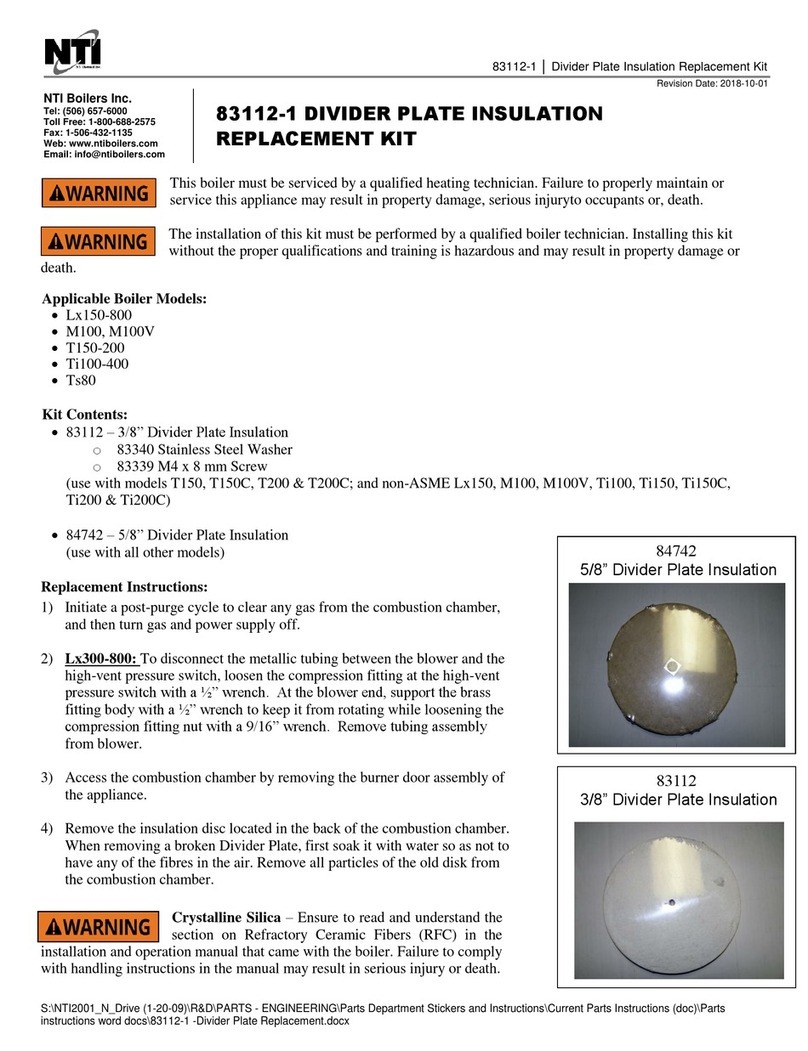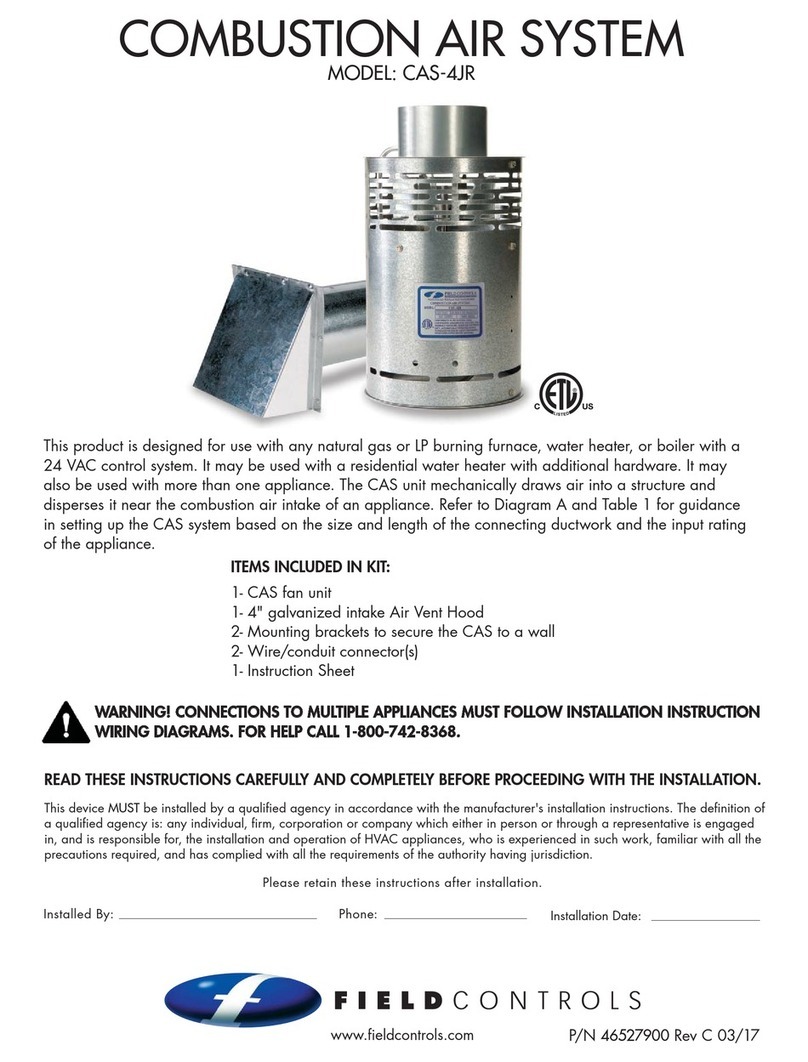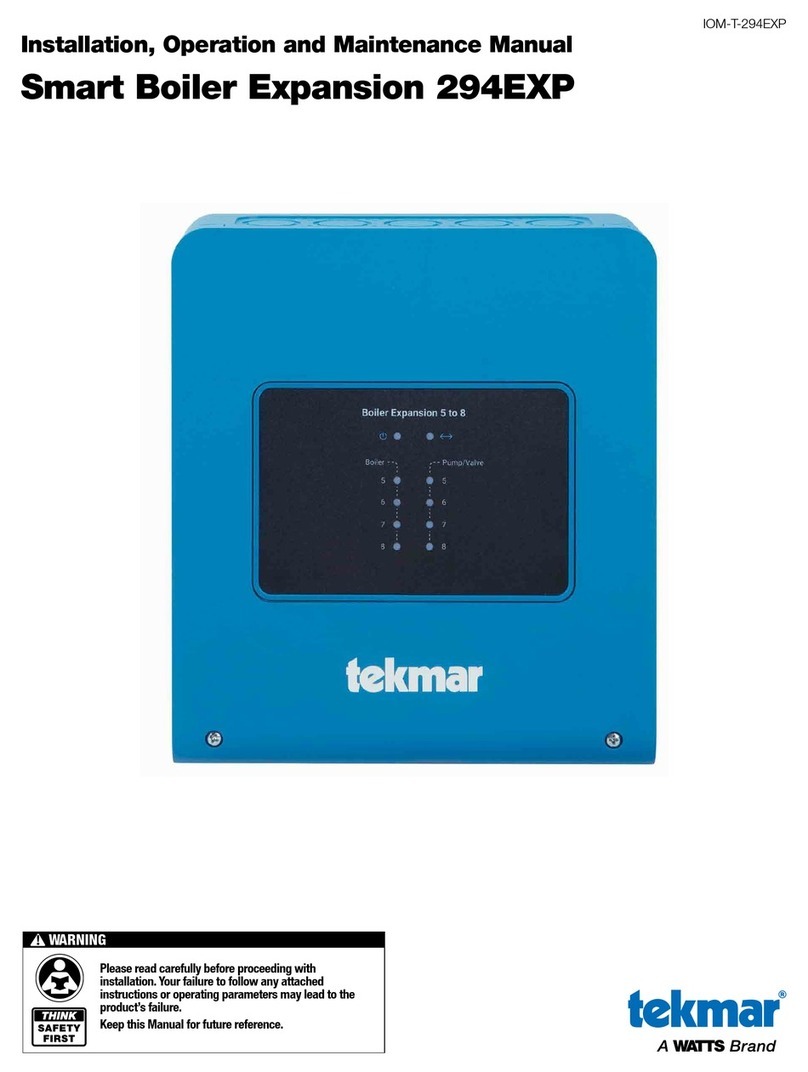NTI FTV110C User manual

FTV110/110C NG-LP Conversion Instructions 1
FTV110/110C
NATURAL TO LP CONVERSION INSTRUCTIONS:
Version Date: 2019-06-20
Kit Numbers: 85995-1
NTI boilers are factory set to operate with Natural Gas. BEFORE OPERATING WITH PROPANE the specified
LP-Venturi Insert must be installed. Use the procedures outlined in these instructions to fully complete the Natural
Gas to LP conversion for models FTV110 & FTV110C.
Kit Contents:
Natural to LP Conversion Instructions (p/n 85996)
Natural to LP Conversion Decal (p/n 85995)
LP-Venturi Insert 27453 39741 (p/n 85989)
These instructions CANNOT be used to convert NTI appliance models not referenced in these
instructions. Contact NTI for the Natural Gas to LP conversion kit and instructions for other
models.
Failure to apply these instructions properly may result in dangerous Carbon Monoxide levels,
fire or explosion leading to property damage, personal injury or death.
ATTENTION: LIQUEFIED PETROLEUM (LP) PROPANE
Liquefied Petroleum (LP) propane gas is heavier than air; therefore, it is imperative that your boiler is not
installed in a pit or similar location that will permit heavier than air gas to collect. Local Codes may require
appliances fueled with LP gas be provided with an approved means of removing unburned gases from the
room. Check your local codes for this requirement.
NTI # 85996
This conversion kit shall be installed by a qualified service agency in accordance with
the manufacturer’s instructions and all applicable codes and requirements of the
authority having jurisdiction. If the information in these instructions is not followed
exactly, a fire, an explosion or production of carbon monoxide may result causing
property damage, personal injury or loss of life. The qualified service agency is
responsible for the proper installation of this kit. The installation is not proper and
complete until the operation of the converted appliance is checked as specified in the
manufacturer’s instructions supplied with the kit, which necessitates the use of a
calibrated CO2/O2and CO combustion analyzer.

2FTV110/110C NG-LP Conversion Instructions
1.0 Installing the LP-Venturi Insert
1. Turn the 120VAC power supply off to the boiler.
2. Remove the front cover from the unit.
3. Remove the air-inlet pipe assembly from inside the boiler (note location of feedback hose between air-inlet pipe
and gas valve).
4. Remove the two screws securing the NG-Venturi Insert to the Venturi Housing see Figure 1-1.
5. Using a small flathead screw driver, gently remove the NG-Venturi Insert from the Venturi Housing (note
orientation of Insert when removing).
6. Clearly label and store the NG-Venturi Insert after removing.
7. Slide the LP-Venturi Insert into the empty Venturi Housing; press firmly in place ensuring the Insert is perfectly
aligned and the Insert DOWN indicator is located at the bottom.
8. Tighten the screws to secure the LP-Venturi Insert to the Venturi Housing.
9. Install the air-inlet pipe assembly; reconnect feedback hose between air-inlet pipe and gas valve.
10.Turn the Throttle Screw clockwise (in) 4 turns.
11.Turn gas on and check for leaks in all gas piping, including the inlet connection to the gas valve, using a soap and
water mixture.
12.Proceed to Section 2.0, Gas Valve and Burner Setup.
Figure 1-1 LP-Venturi Insert Installation and Throttle Screw Pre-set
2.0 Gas Valve and Burner Setup
Failure to perform the Gas Valve and Burner Setup correctly may result in incorrect
operation, component failure, property damage, serious injury or death.
Operating Sequence
Prior to commencing the Gas Valve and Burner Setup, perform the following operating sequence check:
1. Turn the supply of gas to the boiler off.
2. Set the thermostat to the highest setting.
3. Ensure the combustion fan pre-purges for a short time prior to activating the igniter.
Throttle Screw
Turn in (clockwise) 4 turns; then proceed
with Gas Valve and Burner Setup
Gas Valve
*Note DOWN indicator
located at the bottom
Combustion Blower
Venturi Housing
Venturi Insert

FTV110/110C NG-LP Conversion Instructions 3
4. Ensure the combustion fan post-purges for at least 5 seconds prior to reactivating the igniter.
5. Set the thermostat to the lowest setting and continue with the Gas Valve and Burner Setup procedure outlined
below.
Combustion Calibration Procedure
To calibrate burner combustion, perform the following procedure using a calibrated combustion analyzer capable of
measuring CO2and CO from a Natural Gas or Propane burning appliance:
1. Set analyzer to the appropriate fuel (Propane).
2. Gas Line Pressure Test –monitor gas line pressure throughout all combustion tests and verify it is maintained
within tolerance. See Gas Line Pressure Test below.
3. Set Throttle Screw –operate burner to the maximum modulation rate (see Table 2-2); set combustion according
to Table 1-1 using the Throttle Screw; allow time for the analyzer readings to stabilize between adjustments –
record CO2value. See Throttle Screw Adjustment below.
4. Set Offset Screw –operate burner to the minimum modulation rate (see Table 2-2); using the Offset Screw, set
the CO2to 0.4-0.8% lower than the value obtained during the maximum modulation rate test (e.g. if CO2at Max
= 10.5%, then CO2at Min must = 9.7-10.1%). See Offset Screw Adjustment below.
Combustion Calibration is mandatory upon installation and during each annual service.
Failure to perform the Combustion Calibration in accordance with these instructions may
result in incorrect combustion leading to burner damage or excessive Carbon Monoxide
concentrations causing property damage, personal injury or death.
Carbon Monoxide - Never leave the unit operating while producing Carbon Monoxide (CO)
concentrations in excess of 175 ppm. Failure to follow this warning may result in serious
injury or death.
Throttle Screw Adjustment
The gas valve Throttle Screw (see Figure 2-1) is used to calibrate the CO2concentration with the burner operating at
or near the maximum modulation rate (see Table 2-2). Turning the Throttle Screw in (clockwise) decreases the CO2
concentration. Turning the Throttle Screw out (counterclockwise) increases the CO2 concentration. Typical
adjustment required is 0 –1/2of a turn in or out from the position established in Section 1.0 above.
NOTE: Calibration of the Throttle Screw should only be performed with the burner operating at or near the
maximum modulation rate (see Table 2-2).
Adjustments to the Throttle Screw may only be made by a qualified gas technician using a
calibrated combustion analyzer capable of measuring CO2and CO. Adjustments may only be
performed if the gas line pressure is maintained above minimum levels throughout the
duration of the test (see Table 2-1). Failure to follow these instructions may result in serious
injury or death.
Offset Screw Adjustment
The gas valve Offset Screw (see Figure 2-1) is used to calibrate the CO2offset at minimum modulation vs. maximum
modulation. Turning the Offset Screw in (clockwise) increases the CO2 concentration at minimum modulation rate.
Turning the Offset Screw out (counterclockwise) decreases the CO2 concentration at minimum modulation rate.
Typical adjustment required is 0 - 1/8th of a turn in or out from the factory setting.
NOTE: Calibration of the Offset Screw must only be performed with the burner operating at the minimum
modulation rate (see Table 2-2).
Adjustments to the Offset Screw may only be made by a qualified gas technician using a
calibrated combustion analyzer capable of measuring CO2and CO, and only with the burner
at the minimum modulation rate (see Table 2-2). Attempting to set the Offset Screw while the
burner is operating at a modulation rate other than the minimum will result in incorrect
combustion and may lead to burner damage or excessive CO.

4FTV110/110C NG-LP Conversion Instructions
Gas Line Pressure Test
The boiler gas valve is equipped with a Line Pressure Test Port; see Figure 2-1. Use the following procedure to
measure the gas line pressure to the boiler to ensure it falls within the range given in Table 2-1:
1. Turn the supply of gas to the boiler off.
2. Open the bleed screw of the Line Pressure Test Port approximately 1-1/2 turns. This port is directly
connected to the gas line feeding the boiler. See Figure 2-1.
3. Force 1/4ID tubing over the housing of the Line Pressure Test Port; install the other end of the tubing to an
appropriate line pressure test gauge or manometer. Ensure both ends of the tubing make a tight connection.
4. Turn the gas supply to the boiler on and check for gas leaks.
5. Observe the line pressure under static conditions and compare it to Table 2-1. The pressure will be greatest
under static conditions.
6. With all other gas appliances in the application running, operate the burner to the maximum modulation rate
(see Table 2-2) and compare the observed line pressure with Table 2-1. The pressure will be lowest during
the maximum flow of gas, i.e. maximum modulation rate.
7. Adjust the gas line pressure to ensure the parameters in Table 2-1 are attained under all conditions. If possible
adjust the line pressure to the "Nominal/Desired" value listed in Table 2-1 while the unit is operating at the
maximum modulation rate.
8. Continue observing gas line pressure until combustion analysis is complete in case adjustments need to be
made.
9. Complete pressure testing, remove the 1/4" tube from the test port and then return the bleed screw of the Line
Pressure Test Port to the closed position.
The line pressure is a function of the gas supply and is affected solely by field provided
parameters such as line size and regulator settings. Under no circumstances can the boiler gas
valve influence or be used to adjust the gas line pressure.
Failure to close the bleed screw of the Line Pressure Test Port will cause a severe leakage of
gas, resulting in a fire or explosion causing property damage, serious injury or death.
Table 2-1 Line Pressure and Combustion Parameters
Gas
Line Pressure (inches w.c.)
CO2(%)
CO (ppm)
Max.
Nominal/Desired
Min.
Max.
Min.
Max.
Natural
7
4
10.5
9
10
175
Propane
11
8
13
10
11
175
Notes:
1Combustion calibration must only be performed with the burner operating at maximum modulation rate; when tested at
minimum modulation rate the CO2must be 0.4-0.8% lower than CO2at maximum modulation rate.
Table 2-2 Minimum and Maximum Modulation and Input Rates
Model
Gas
Appliance
Number
Min. Modulation Rate
(RPM)
Max. Modulation Rate
(RPM)
Input Rate (MBH)
Min
Max 1
FTV110
NG
16
1620
7620
11
110
LP
22
1860
8040
FTV110C
NG
19
1620
7620
LP
23
1860
8040
Notes:
1Canada: Altitudes between 2000-4500 ft, de-rate by 10%. Consult local authorities for de-rating for altitudes above 4500ft.
2Use Installer Menu setting 2-15 to force the burner to operate at the max. (2-15 = 3) and min. (2-15 = 1) modulation
rates; see Section 17.0 DISPLAY MENU GUIDE of the boiler Installation and Operation Manual.

FTV110/110C NG-LP Conversion Instructions 5
Figure 2-1 Gas Valve and Venturi Assembly
Offset Screw –used to set
combustion at min. modulation rate
(use 2 mm hex wrench)
Gas Valve
Venturi
Throttle Screw –used to calibrate
combustion at max. modulation rate
Line Pressure Test Port

6FTV110/110C NG-LP Conversion Instructions
3.0 Labeling
As the certified installer of the Natural Gas to LP Conversion Kit, you must indicate on the boiler that it has been
converted for use with Propane (LP) Gas:
1. Update Rating Plate Decal –Locate the rating plate decal on the side of the appliance, using a regular ink pen,
check the box next to “Field converted to Propane Gas” and fill in the date; depress hard enough to permanently
etch the decal (see Figure 3-1).
2. Conversion Decal - Fill out the required information on the Conversion Decal (included in this kit) and affix it to
the boiler cabinet adjacent to the rating plate decal, and in a location where it can be easily seen (see Figure 3-2).
Figure 3-1 Update the Rating Plate Decal
Figure 3-2 Conversion Decal
X
x
May 5, 2016
John Smith
22
This manual suits for next models
1
Table of contents
Other NTI Boiler Supplies manuals







